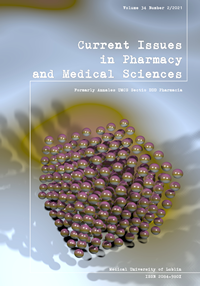An educational review on Probiotics
DOI:
https://doi.org/10.2478/cipms-2021-0020Keywords:
foods, microorganisms, diseases, bacteria, ProbioticsAbstract
Probiotics are live microorganisms that appear to provide health benefits when swallowed or introduced to the body. They are present in dairy and other fermented foods, as well as in dietary supplements and cosmetics. While many people still believe bacteria and other microorganisms are harmful “germs”, many are beneficial. Certain bacteria aid in the digestion of food, destroy disease-causing cells and absorb vitamins. Some of the microorganisms found in probiotic products are similar to or identical to those found naturally in our bodies. This article provides sufficient data to support the use of probiotics in a variety of uncommon clinical diseases, including skin disorders, Parkinson's disease, psychiatric disorders, liver transplantation, diabetic foot and periodontal care.
References
1. Hajela N, Ramakrishna B, Nair G, Abraham P, Gopalan S, Ganguly N. Gut microbiome, gut function, and probiotics: Implications for health. Indian Gastroenterol. 2015;34(2):93-107.
2. Probiotic Drinks – How do they work and Top 9 probiotic drinks in India. Stylecraze; 2020. Available from: https://www.stylecraze.com/articles/probiotic-drinks-available-in-india/(cited 2 June 2020)
3. Boindala S, Lewis J. The grand challenge of regulating health foods in India. Indian J Med Res. 2019;150(3):248.
4. Raghuwanshi S, Misra S, Sharma R, PS B. Probiotics: Nutritional therapeutic tool. J Prob Health. 2018;06:1.
5. Rodgers S. Incorporation of probiotic cultures in foodservice products: an exploratory study. J Foodservice. 2007;18(3):108-18.
6. Arora M, Baldi A. Comparative study of regulatory framework for probiotics: Current status and future recommendations. Appl Clinl Res Clin Trials Regul Aff. 2017;4(2):140-57.
7. Baldi A. Comparative insight of regulatory guidelines for probiotics in USA, India and Malaysia: A Critical review. Int J Biotech Well Indus. 2013;2(2):51-64.
8. Fijan S, Frauwallner A, Langerholc T, Krebs B, ter Haar (née Younes) J, Heschl A, et al. Efficacy of using probiotics with antagonistic activity against pathogens of wound infections: An integrative review of literature. BioMed Res Int. 2019;2019:1-21.
9. Venosi S, Ceccarelli G, de Angelis M, Laghi L, Bianchi L, Martinelli O, et al. Infected chronic ischemic wound topically treated with a multi-strain probiotic formulation: a novel tailored treatment strategy. J Trans Med. 2019;17(1).
10. Roudsari MR, Karimi R, Sohrabvandi S, Mortazavian AM. Health effects of probiotics on the skin. Crit Rev Food Sci Nutr. 2015; 55(9):1219-40.
11. Yang D, Zhao D, Ali Shah S, Wu W, Lai M, Zhang X, et al. The role of the gut microbiota in the pathogenesis of Parkinson’s disease. Front Neurol. 2019;10.
12. Scheperjans F, Aho V, Pereira PA, Koskinen K, Paulin L, Pekkonen E, et al. Gut microbiota are related to Parkinson’s disease and clinical phenotype. MDS. 2015;30(3):350-8.
13. Magistrelli L, Amoruso A, Mogna L, Graziano T, Cantello R, Pane M, et al. Probiotics may have beneficial effects in Parkinson’s disease: In vitro evidence. Front Immunol. 2019;10.
14. Ganci M, Suleyman E, Butt H, Ball M. The role of the brain–gut–microbiota axis in psychology: The importance of considering gut microbiota in the development, perpetuation, and treatment of psychological disorders. Brain Behav. 2019;9(11):e01408.
15. Jorgenson MR, Descourouez JL, Siodlak M, Tjugum S, Rice JP, Fernandez LA. Efficacy and safety of probiotics and synbiotics in liver transplantation. Pharmacother J Hum Pharmacol Drug Ther. 2018;38(7):758-68.
16. Fijan S, Frauwallner A, Varga L, Langerholc T, Rogelj I, Lorber M, et al. Health professionals’ knowledge of probiotics: An international survey. Int J Environ Res Public Health. 2019;16(17):3128.
17. Gupta V, Gupta B. Probiotics and periodontal disease: A current update. J Oral Health Comm Dent. 2010;4(Spl):35-7.
Downloads
Published
Issue
Section
License
Copyright (c) 2021 Authors

This work is licensed under a Creative Commons Attribution-NonCommercial-NoDerivatives 3.0 Unported License.


